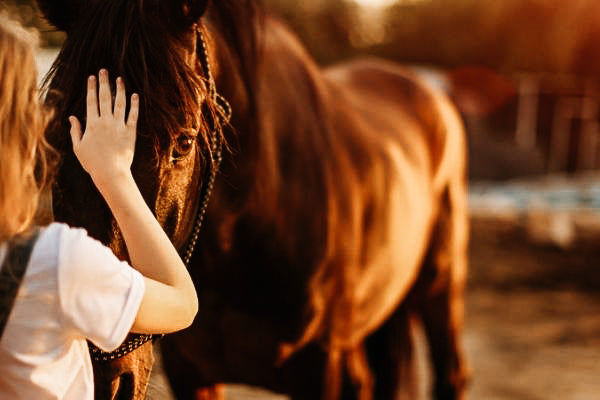
Natural Horsemanship – an attitude that every horse understands
Everyone has heard of it: Natural Horsemanship. Since Pat Parelli's relevant publications, the hype with the waving rope has never stopped. In fact, it's much more than swinging a stick.
The work of a horse whisperer begins as soon as his eyes wander over the paddock, his foot enters the stable or he hears his horse snorting. There is a magical connection in the air and you immediately feel that something is different here. But what?
We would be happy to offer you a little insight into natural horsemanship. Maybe you'll get a taste for it and pick up a few tips for you and your horse for your time together.
What is Natural Horsemanship anyway?
Horsemanship is a way of thinking, an attitude to life and a feeling of doing the right thing for horses in a natural way. It is not a training program for horses, even though there are many great horsemanship exercises. Training and special techniques are tailored to the animal's needs.
The horse's well-being always comes first. Rather, it is an observation and perception on the part of the human (the horse does this all the time anyway) and a joint development in the right direction for both.
The right approach, especially for a problem horse!
The right horsemanship equipment
Every horse trainer now offers their own special work equipment. You can also find a small selection of various aids in equestrian shops. The price range varies considerably.If the name of the well-known horse whisperer is included, you'll quickly find yourself a few pennies poorer. Which isn't to say that these items are bad. On the contrary, this equipment is usually well thought out. For example, many of the ropes used by professionals are made from robust yacht rope with a so-called “living inner core”. This core enables very precise communication with the horse. Every movement of your hand, no matter how small, sends the impulse across the 4 m rope to your four-legged partner.
Try it out with a friend! Everyone holds one end and only one person gently shakes the end of the rope. You will be amazed at this effect.
What else do we need?
A comfortable knot halter and a horsemanship stick (120 cm) are important.
With the “Knoti” it is important to ensure that it is purchased with a perfect fit, put on correctly and used carefully. If handled improperly, it can appear very sharp! You can find instructions on how to correctly put on the halter online. A video can be of great help to you!
The stick mentioned above is also called “carrot stick”. It is usually orange in color (like a carrot) and has a rope (Savvy String = 180 cm) at the end. This stick is the perfect extension of your arm and you can better explain many signals to the horse. For example, praise him from a distance or protect your personal space.
With special horsemanship equipment we can simply make ourselves even more understandable. The horse understands this type of “entertainment” very well. The horse's signals are received very finely via the posture of the stick, rope and knot halter. The result is a great, vivid and almost invisible (for professionals) dialogue between humans and animals.
Horsemanship exercises that everyone can learn!
The well-known Pat Parelli has put together various exercises. He calls them the seven games. These can be practiced with the horse at different levels (levels of difficulty).
The seven games are composed as follows:
- Friendly Game (Friendly Game)
- Porcupine Game (porcupine game)
- Driving Game (Driving Game)
- Yoyo Game
- Circling Game (circling game)
- Sideway Game (Sideway Game)
- Squeeze Game (Squeeze Game)
Initially, ground work with the horse is crucial. It forms a solid base and prepares the horse for work in the saddle. All of the games mentioned can therefore be “played” as ground work with a horse and can continue to progress (e.g. b first on the pitch, then off-road or with the addition of obstacles such as barrels etc.) continue into the saddle.
Parelli essentially gives you a guide that has made natural horsemanship so refined.
Even a problem horse (unfortunately usually a man-made one!) will soon find its way around these interactions, which are based on natural horse behavior.
Ground work brings the horse back to the beginning. Eventually it understands these and can then engage with our predictable actions. As a horse whisperer, you also accept that animals with a history of stress need time and patience.
Where can I learn this?
We have to be very grateful to Parelli. He lets us share in his revelation and not just through the extensive courses offered by his trained instructors (e.g. b Berni Zambail).
Books, DVDs, public videos and finally the entire network of the Internet make it easier for us to contact Natural Horsemanship. Because this type of horse communication is actually “learning by doing”.
After all, a real horse whisperer didn't fall from heaven.
_________________________________________________________________________________________________________________________
The following is a guest article on the topic of "Natural Horsemanship" by Sarah Brummer
What does Natural Horsemanship mean to me?
People can learn to appreciate the nature of the horse. This means he can learn to recognize the nature, character and basic needs of the horse and respond to them first.
The holistic view of the horse and the person is trained.
If a part of the whole is not taken into account, the balance can be disturbed.
The goal is to be in harmony with nature, to find your personal balance and to learn to center yourself.
Areas that you can get to know as a horse owner, or Specialists should be brought to the side are:
- Behavioral theory
- Stance
- Feeding
- Hoof trimming
- Dental treatment
- Movement theory
- Anatomy
- Equipment customer
- Physiotherapy
- Breeding goals
- Race
- .Etc.
In my opinion, a true partnership with the horse can only emerge when we as humans make an effort to engage with the horse and its issues as much as we can and are willing to constantly develop ourselves further.
In a natural horsemanship lesson, people learn to become aware of themselves through conversation with the horse. People learn movements with which they can make themselves understood by the horse. People learn to be empathetic, to recognize the horse at every second and then to act depending on the situation.
The goal of every conversation is to relax and then open up to each other.
Because horses and humans can only think and learn through mutual relaxation.
Horses and people have different ways of reacting to uncertainty in conversation.
We can fall into the following behavioral patterns:
- Attack / Self-defense
- Escape
- Play dead / freeze to death
- Block
- Argument and discussion
The goal is to clarify the latter disputes and uncertainties. Only when we talk to each other can we build a sustainable partnership.
We as humans have the task of explaining the human world to the horse, an escape animal.
Sincerely,
Sarah Brummer
We would like to take this opportunity to thank Sarah very much for this great guest post.
Discover more posts

Friese – the versatile, impressive black horses
Of all horse breeds, the Friesian is a horse that particularly stands out due to its impressive appearance. These noble animals were popular at the beginning of the 20th century. In the 19th c...
Continue reading
The American Quarter Horse – a highly motivated, easy-going partner
With more than 4.6 million registrations, this horse breed holds the record in terms of popularity worldwide. No other breed has so many representatives at the start. And this majority does no...
Continue reading
